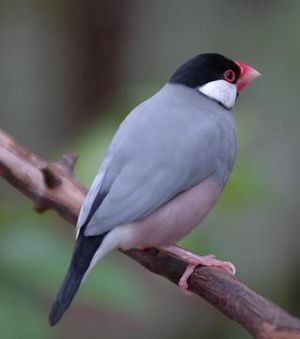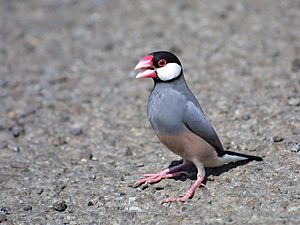Java sparrow facts for kids
Quick facts for kids Java sparrow |
|
|---|---|
 |
|
| Conservation status | |
| Scientific classification | |
| Genus: |
Lonchura
|
| Species: |
oryzivora
|
| Synonyms | |
|
|
The Java sparrow (Lonchura oryzivora) is a small bird known for its beautiful looks. People also call it the Java finch, Java rice sparrow, or Java rice bird. It belongs to a group of birds called passerines, which are perching birds. This bird is a type of estrildid finch, a family of small seed-eating birds.
Java sparrows naturally live and breed in Java, Bali, and Bawean islands in Indonesia. They are very popular as pet birds and have been taken to many other countries around the world. Some scientists believe this bird and the Timor sparrow should be in their own special group, called Padda.
Contents
Discover the Java Sparrow
The Java sparrow is a medium-sized bird, usually about 15 to 17 cm (5.9 to 6.7 in) long. This measurement is from its beak to the tip of its tail feathers. Even though it's only about the size of a house sparrow, it might be the biggest bird in the estrildid finch family.
What Does It Look Like?
Adult Java sparrows are easy to spot. They have grey feathers on their back and chest. Their belly is a pretty pink color. Their head is black with bright white patches on their cheeks. They have a red ring around their eyes and pink feet. Their bill is thick and red.
Both male and female Java sparrows look very similar. Young birds, called immatures, have brown feathers on their upper parts and light brown feathers underneath. Their heads are plain brown. Very young birds have a black beak with a pink base.
Sounds of the Java Sparrow
The Java sparrow makes a simple chip sound. When it sings, it makes a quick series of these call notes, like chipchipchipchipchipchip.
Where Java Sparrows Live
Java sparrows are very social birds. They like to live in groups and often feed together. Their main food is grain and other seeds. You can often find them in open grasslands and farm areas. Long ago, they were sometimes seen as a pest in rice fields because they ate the rice. This is why their scientific name includes "oryzivora," which means "rice-eater."
Nesting and Eggs
Java sparrows build their nests in trees or on buildings. A female Java sparrow can lay up to eight eggs at one time.
Java Sparrows as Pets
Java sparrows have been popular cage birds in Asia for hundreds of years. They were first kept as pets in China during the Ming Dynasty. Then, from the 17th century, they became popular in Japan. You can often see them in old Japanese paintings and prints. A famous Japanese writer, Natsume Sōseki, even wrote an essay about his pet Java sparrow.
In the late 1960s and early 1970s, the Java sparrow was one of the most popular pet birds in the United States. However, importing them was later stopped. Today, it is still against the law to own them in California. This is because people worry they might harm farms, especially rice crops. But in Asian countries like China, Taiwan, and Japan, which also grow a lot of rice, these birds are not regulated.
Tame and Colorful Birds
In Asia, many Java sparrows are raised by humans almost from the time they hatch. This makes them very tame and friendly towards people. Because they are so tame, they can often be kept in smaller cages. Owners can even let them out for exercise indoors without them trying to fly away.
Breeders have created many different colors of Java sparrows in captivity. These include white, silver, fawn, pastel, cream, and agate. There are also pied Java sparrows, which have patches of different colors. In Japan, the pied variety is called sakura buncho.
Where They Have Been Introduced
The Java sparrow has been brought to many places outside its natural home. It was introduced to the Indian subcontinent, but it did not become a successful resident there. In the United States, there are groups of breeding Java sparrows on several of the Hawaiian Islands, especially Oahu.
In the Caribbean, the Java sparrow was introduced to Puerto Rico. It is quite common near San Juan. It has also been seen in Jamaica, but it is not known to live on any other Caribbean islands. It was also brought to Christmas Island, which is off the coast of Western Australia.
Protecting the Java Sparrow
Many countries consider the Java sparrow an agricultural pest because it eats rice crops. However, the number of Java sparrows in the wild has become much smaller. This is due to losing their natural homes, hunting in some areas, and being trapped as pests in others. Seeing them in their natural habitats is becoming less common.
The Java sparrow is now listed as endangered on the IUCN Red List of Threatened Species. This means it is at a very high risk of becoming extinct in the wild. It was changed from "vulnerable" to "endangered" in 2018. The species is also listed on Appendix II of CITES, which controls the trade of endangered animals. According to TRAFFIC, the Java sparrow is also seriously threatened by the illegal pet trade. People illegally seek them for their unique song.
See also
 In Spanish: Capuchino arrocero de Java para niños
In Spanish: Capuchino arrocero de Java para niños




